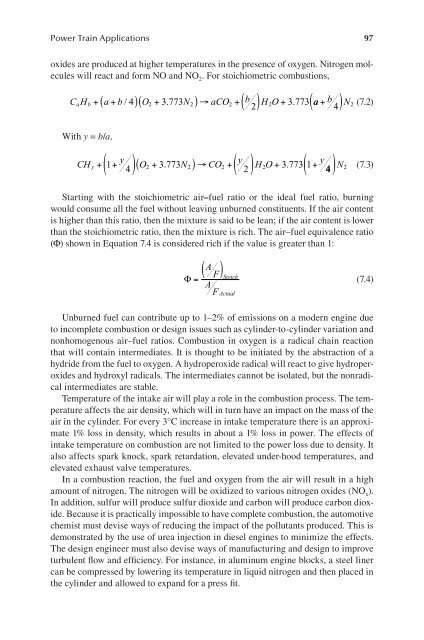THE ROLE OF THE
THE ROLE OF THE
THE ROLE OF THE
You also want an ePaper? Increase the reach of your titles
YUMPU automatically turns print PDFs into web optimized ePapers that Google loves.
Power Train Applications 97<br />
oxides are produced at higher temperatures in the presence of oxygen. Nitrogen molecules<br />
will react and form NO and NO 2. For stoichiometric combustions,<br />
( ) +<br />
( )→ +( ) +<br />
CH a b O N aCO b<br />
a b + + / 4 3. 773<br />
2<br />
HO 3. 773<br />
With y = b/a,<br />
( ) +<br />
( )<br />
2 2 2 2 a b + N<br />
( )<br />
CH<br />
y<br />
O N CO<br />
y<br />
HO<br />
y<br />
y + 1+<br />
( 2 4<br />
3. 773 2)→ 2 +( 2 ) 2 + 3. 773 1+<br />
4 2 (7.2)<br />
4 2<br />
N (7.3)<br />
Starting with the stoichiometric air–fuel ratio or the ideal fuel ratio, burning<br />
would consume all the fuel without leaving unburned constituents. If the air content<br />
is higher than this ratio, then the mixture is said to be lean; if the air content is lower<br />
than the stoichiometric ratio, then the mixture is rich. The air–fuel equivalence ratio<br />
(Φ) shown in Equation 7.4 is considered rich if the value is greater than 1:<br />
Φ=<br />
( )<br />
A F<br />
A F<br />
Stoich<br />
Actual<br />
(7.4)<br />
Unburned fuel can contribute up to 1–2% of emissions on a modern engine due<br />
to incomplete combustion or design issues such as cylinder-to-cylinder variation and<br />
nonhomogenous air–fuel ratios. Combustion in oxygen is a radical chain reaction<br />
that will contain intermediates. It is thought to be initiated by the abstraction of a<br />
hydride from the fuel to oxygen. A hydroperoxide radical will react to give hydroperoxides<br />
and hydroxyl radicals. The intermediates cannot be isolated, but the nonradical<br />
intermediates are stable.<br />
Temperature of the intake air will play a role in the combustion process. The temperature<br />
affects the air density, which will in turn have an impact on the mass of the<br />
air in the cylinder. For every 3°C increase in intake temperature there is an approximate<br />
1% loss in density, which results in about a 1% loss in power. The effects of<br />
intake temperature on combustion are not limited to the power loss due to density. It<br />
also affects spark knock, spark retardation, elevated under-hood temperatures, and<br />
elevated exhaust valve temperatures.<br />
In a combustion reaction, the fuel and oxygen from the air will result in a high<br />
amount of nitrogen. The nitrogen will be oxidized to various nitrogen oxides (NO x).<br />
In addition, sulfur will produce sulfur dioxide and carbon will produce carbon dioxide.<br />
Because it is practically impossible to have complete combustion, the automotive<br />
chemist must devise ways of reducing the impact of the pollutants produced. This is<br />
demonstrated by the use of urea injection in diesel engines to minimize the effects.<br />
The design engineer must also devise ways of manufacturing and design to improve<br />
turbulent flow and efficiency. For instance, in aluminum engine blocks, a steel liner<br />
can be compressed by lowering its temperature in liquid nitrogen and then placed in<br />
the cylinder and allowed to expand for a press fit.







